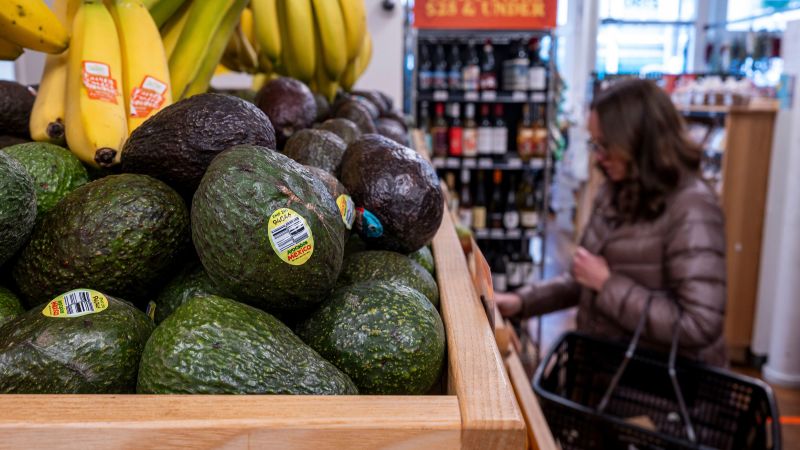CNN
—
On Saturday, President Donald Trump made good on his promise to impose steep tariffs on America’s three largest trading partners — Canada, China and Mexico — citing a national emergency on the flow of fentanyl and undocumented immigrants into the United States.
The action, which is expected to take effect on Tuesday, includes a 25% duty on all imports from Mexico and most goods from Canada (there’s a 10% carve-out for energy-related items such as crude oil), and an additional 10% tariff on Chinese goods imported into the United States.
Trump has used and promised to employ tariffs for three primary purposes: to raise revenue, to bring trade into balance and to bring rival countries to the negotiating table.
However, economists warn that these moves negatively impact American businesses and consumers, many of whom are still reeling from the sharp rise in inflation in recent years.
The US Chamber of Commerce warned Saturday that tariffs won’t solve the yearslong issues at the borders and instead threaten to “upend supply chains” and raise prices for American families.
“Consumers are going to be clearly worse off,” Sung Won Sohn, professor of finance and economics at Loyola Marymount University and chief economist at SS Economics, told CNN on Saturday.
“When you talk about a tariff, it’s an economic war; and in war, everybody loses,” he added. “But hopefully we will come to some better results and conclusions as a result of the pain and suffering that we will go through.”
About one-third of US imports come from the three countries Trump targeted Saturday. Their products are among some of the most commonplace and critical items used by Americans, including fruits and vegetables, meat, gas, automobiles, electronics, toys, clothing, lumber, and beer and spirits.
Mexico and Canada supply a significant share of several key food categories. For example, Mexico is the largest supplier of fruit and vegetables to the US, while Canada leads in exports of grain, livestock and meats, poultry and more.
Agricultural products from Mexico and Canada, in particular, could become more expensive for consumers, as grocery retailers operate on thinner profit margins than most industries. With little room to absorb higher tariff costs, the grocers may have to pass them on to shoppers.
Although the US typically exports more agricultural goods than it imports, the value of imports has increased faster than that of exports in the past decade, according to the US Department of Agriculture. Additionally, climate change has increased US reliance on countries like Mexico, where growing conditions are more favorable.
Last year, the US imported $46 billion of agricultural products from Mexico, according to USDA data. That includes $8.3 billion worth of fresh vegetables, $5.9 billion of beer and $5 billion of distilled spirits.
But the biggest category of agricultural imports from Mexico last year was fresh fruits, of which the US imported $9 billion worth, with avocados accounting for $3.1 billion of that total.
Fuel and energy
The US imported $97 billion worth of oil and gas from Canada last year, that country’s top export to the US. The US has become more reliant on Canadian oil since the expansion of Canada’s Trans Mountain pipeline, according to data from the US Energy Information Administration.
The tariff on Canadian energy products is only 10%, not the 25% tariff announced on other Canadian exports.
That’ll limit the impact on gasoline prices, said Tom Kloza, global head of energy analysis for OPIS.

Another factor is the time of year. Gas prices are typically near a low for the year in February due to weak demand. If the tariffs stay in place through summer, the impact will be greater, he said.
And while the impact isn’t expected to be felt equally nationwide, it likely will hit America’s Heartland the hardest.
Most Canadian oil is shipped to Midwest refineries via pipeline, Kloza said. The states most likely to be affected are Idaho, Illinois, Indiana, Iowa, Kansas, Kentucky, Michigan, Minnesota, Missouri, Montana, Nebraska, North Dakota, Ohio, Pennsylvania, South Dakota and Wisconsin, he said.
“Interestingly, 12 of those 16 states begin February with an average retail gasoline price under $3 a gallon,” he said. “That probably won’t last.”
Cars and car parts
The US imported $87 billion worth of motor vehicles and $64 billion worth of vehicle parts from Mexico last year, not accounting for December, the top two goods imported from there that year, according to Commerce Department data. (December trade data is due out next week.)
Motor vehicles were also the second-largest good the US imported from Canada last year through November, for a total of $34 billion.
The auto sector is likely “apoplectic” about the new potential tariffs, said Mary Lovely, a senior fellow at the Peterson Institute for International Economics. US car companies have been able to keep production costs down by hiring lower-wage workers, particularly in Mexico, where much of their production has shifted to in recent years.
But that cost saving will essentially be erased if there’s a 25% tariff, she said. Car manufacturers are unlikely to move their production elsewhere, given they’ve made sizable investments in existing plants in both countries and it is difficult to source all the raw materials to build cars and their parts from other places.
While the United States is not the manufacturing-focused economy it once was, it still consumes tens of millions of tons of steel a year, feeding industries such as automaking, oil production, construction and infrastructure.
Canada and Mexico are the largest and third-largest exporters of steel to the United States, respectively. In his first term, President Trump imposed tariffs of 25% on steel imports from most nations worldwide effective June 2018. But Mexico and Canada, under their free trade deals with the United States, were exempt from those tariffs.
Canada now accounts for nearly a quarter of steel imported by American businesses by weight, while Mexico accounts for about 12%, according to government data provided by the American Iron and Steel Institute, an industry trade group.
However, there is empirical evidence showing that the 2018 tariffs on steel and aluminum did raise prices, Won Sohn said, noting a 2020 Federal Reserve study that found an increase in producer prices, which eventually were passed along to consumers.
Beer and alcohol
Beer and liquor may be recession-proof, but they’re certainly not tariff-proof.
The result would be a stiff penalty on some of America’s favorite libations, including tequila, which can be made only in Mexico and the No. 1 beer brand in the nation, Modelo.
Constellation Brands, which imports Modelo and Corona beer as well as Casa Noble tequila from Mexico, could see its costs leap 16% under Trump’s proposed tariff and would likely have to raise prices by about 4.5%, Chris Carey, a Wells Fargo equity analyst, wrote in a November note.
In 2023, the US imported $5.69 billion of beer and $4.81 billion of alcohol from Mexico, according to International Trade Administration data. When combined, the two categories were the 10th-biggest import from Mexico last year and mark a sharp 126% increase from 2017, International Trade Administration data shows.
While the tariffs could cause further increases in key materials (such as steel, aluminum and grain) for US beer and spirits businesses, the industry is also bracing for the potential of retaliatory tariffs.
Home construction and furniture
Softwood lumber, which is sourced from the likes of pine, spruce, firs and other conifers is prized for its light weight, workability and strength.
As such, its applications are vast, but it’s a critical ingredient in the US homebuilding industry: Commonly, the skeleton and skin of homes — the framing, roof and siding — consist of softwood lumber.
And 30% of what the US uses annually comes from Canada.
Economists and homebuilders caution that America does not currently have the industrial capacity to meet the demand and that taxing — or worse, cutting off — Canadian lumber imports could further exacerbate the ongoing housing affordability crisis.
“Whether it’s lumber tariffs or tariffs on any other import, these can impact the supply chain,” said Nick Erickson, senior director of housing policy for Housing First Minnesota, a trade organization that represents builders, remodelers and other businesses in the North Star State. “And we’ve seen in the past that tariffs on lumber, these are paid for by new homebuyers in the cost of their home.”

And it’s not just lumber at risk for tariffs: 71% of the imported $456 million of lime and gypsum (which are used for drywall) came from Mexico in 2023, according to the National Association of Home Builders.
Factoring in the other raw materials and components imported from Canada, Mexico, as well as China (notably the steel, aluminum and home appliances already subject to tariffs), Trump’s new tariffs could raise the cost of imported construction materials by $3 billion to $4 billion, the NAHB noted.
Consumer electronics are among the top goods the US imported from China last year, according to federal trade data. That includes cellphones, TVs, laptops, video game consoles, monitors and all the components that power them.
China also is a major supplier of home appliances. Those along with toys and footwear are particularly exposed to Trump’s tariff threats.
A staggering 99% of shoes sold in the United States are imported, according to the Footwear Distributors & Retailers of America, a trade group that represents Nike, Steve Madden, Cole Haan and other footwear brands.
More than half (56%) of shoes sold in the United States are made in China, the trade group said.
The United States is also reliant on China for toys and sporting equipment, including items such as footballs, soccer balls and baseballs. The United States gets 75% of its imported toys and sports equipment from China.















